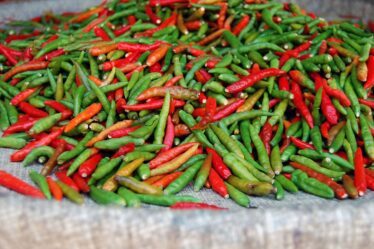
Chili powder is a popular spice used in many cuisines around the world. It is known for its unique flavor and heat that can add depth and complexity to dishes. Whether you’re making a spicy chili con carne or adding a kick to your favorite marinade, chili powder is a versatile ingredient that can elevate any dish.
The flavor of chili powder can vary depending on the type of chili peppers used and the method of preparation. Some chili powders have a smoky, earthy flavor, while others are more fruity and vibrant. The heat level can also vary, from mild to extremely hot. This allows you to customize the level of spiciness in your dishes to suit your taste.
Key Takeaways
- Chili powder is a fiery flavor enhancer that adds heat and depth to dishes.
- Chili powder has a rich history dating back to the Aztecs and has evolved over time.
- There are different types of chili powder, each with its unique flavor profile and heat level.
- Chili powder has health benefits, including boosting metabolism and fighting inflammation.
- Making your own chili powder is easy and allows you to customize the flavor to your liking.
The History of Chili Powder: From the Aztecs to Modern Times
The origins of chili powder can be traced back to the Aztecs, who were known for their love of spicy foods. They used chili peppers in their cooking for both flavor and medicinal purposes. The Aztecs believed that chili peppers had healing properties and could ward off evil spirits.
Over time, chili powder spread to other parts of the world through trade routes and colonization. It became a staple in many cultures, including Mexican, Indian, and Thai cuisines. Each culture has its own unique way of using chili powder, whether it’s in a traditional mole sauce or a spicy curry.
Today, there are many different varieties of chili powder available, each with its own distinct flavor profile. Some popular types include ancho, cayenne, and chipotle. Ancho chili powder is made from dried poblano peppers and has a mild, slightly sweet flavor. Cayenne chili powder is made from dried cayenne peppers and is known for its intense heat. Chipotle chili powder is made from smoked jalapeno peppers and has a smoky, rich flavor.
Different Types of Chili Powder: An Overview
There are several different types of chili powder available, each with its own unique flavor and heat level. Ancho chili powder is made from dried poblano peppers and has a mild, slightly sweet flavor. It is often used in Mexican cuisine, particularly in mole sauces and chili con carne.
Cayenne chili powder is made from dried cayenne peppers and is known for its intense heat. It has a bright, fiery flavor that can add a kick to any dish. Cayenne chili powder is commonly used in Indian and Thai cuisines, as well as in spicy marinades and rubs.
Chipotle chili powder is made from smoked jalapeno peppers and has a smoky, rich flavor. It adds depth and complexity to dishes, particularly those with a barbecue or southwestern flair. Chipotle chili powder is often used in chili, tacos, and salsas.
When choosing which type of chili powder to use in a recipe, consider the flavor profile you’re looking for and the level of heat you can handle. If you prefer milder flavors, opt for ancho chili powder. If you like things spicy, go for cayenne or chipotle chili powder.
Culinary Uses of Chili Powder: Adding Heat and Flavor to Your Dishes
| Culinary Uses of Chili Powder | Benefits |
|---|---|
| Adding heat to dishes | Enhances flavor and adds a spicy kick |
| Seasoning meats | Creates a flavorful crust and tenderizes meat |
| Spicing up soups and stews | Provides depth of flavor and warmth |
| Adding to marinades | Infuses meat with flavor and tenderizes |
| Making sauces and dips | Creates a bold and spicy flavor profile |
Chili powder can be used in a variety of ways to add heat and flavor to your dishes. One popular use is in marinades and rubs for meats and vegetables. The heat from the chili powder helps to tenderize the meat while adding a spicy kick. It can also be used to season vegetables before grilling or roasting.
Chili powder is also a key ingredient in many sauces and salsas. It adds depth and complexity to the flavors, making them more vibrant and exciting. Whether you’re making a spicy salsa for tacos or a tangy barbecue sauce for ribs, chili powder is a must-have ingredient.
One classic dish that benefits from the addition of chili powder is chili con carne. The chili powder adds a rich, smoky flavor to the dish, while the heat from the peppers gives it a spicy kick. Other dishes that can be enhanced with chili powder include soups, stews, and even desserts.
When using chili powder in your cooking, it’s important to use it in moderation. While it can add a lot of flavor and heat to a dish, too much can overpower the other flavors. Start with a small amount and taste as you go, adding more if needed. This will allow you to control the level of spiciness and ensure that the other flavors in your dish are not overwhelmed.
Health Benefits of Chili Powder: From Boosting Metabolism to Fighting Inflammation
In addition to its delicious flavor, chili powder also offers several potential health benefits. One of the most well-known benefits is its ability to boost metabolism. The compound responsible for this is called capsaicin, which gives chili peppers their heat. Capsaicin has been shown to increase metabolism and promote fat burning.
Chili powder also contains antioxidants, which help to fight inflammation in the body. Chronic inflammation has been linked to a variety of health conditions, including heart disease, diabetes, and certain types of cancer. Consuming foods that are high in antioxidants, such as chili powder, can help to reduce inflammation and protect against these diseases.
Several scientific studies have supported these claims. One study published in the American Journal of Clinical Nutrition found that consuming capsaicin-rich foods increased fat oxidation and energy expenditure in both men and women. Another study published in the Journal of Clinical Investigation found that capsaicin reduced inflammation in mice with colitis.
While chili powder can offer health benefits when consumed in moderation, it’s important to note that consuming it in excess can have negative effects. Some people may experience digestive issues, such as heartburn or stomach pain, when consuming large amounts of chili powder. It’s also important to consider any dietary restrictions or allergies you may have before incorporating chili powder into your diet.
How to Make Your Own Chili Powder: A Step-by-Step Guide

Making your own chili powder at home is a fun and rewarding process. Not only does it allow you to customize the flavor and heat level to your liking, but it also ensures that you’re using fresh, high-quality ingredients. Here’s a step-by-step guide to making chili powder at home:
1. Select your chili peppers: Start by choosing the type of chili peppers you want to use. You can use a single variety or a combination of different peppers for a more complex flavor. Some popular choices include ancho, cayenne, and chipotle peppers.
2. Dry the peppers: Once you’ve chosen your peppers, you’ll need to dry them. This can be done by hanging them in a well-ventilated area or using a dehydrator. The peppers should be completely dry before grinding them into powder.
3. Remove the stems and seeds: Once the peppers are dry, remove the stems and seeds. These can be discarded or saved for another use, such as making hot sauce.
4. Grind the peppers: Using a spice grinder or a mortar and pestle, grind the dried peppers into a fine powder. You can also add other spices, such as cumin or garlic powder, for added flavor.
5. Store the chili powder: Transfer the chili powder to an airtight container and store it in a cool, dark place. This will help to preserve its freshness and flavor.
Tips for Storing and Using Chili Powder: Keeping the Flavor Fresh
To ensure that your chili powder stays fresh and flavorful, it’s important to store it properly. Here are some tips for storing and using chili powder:
– Store chili powder in an airtight container in a cool, dark place. This will help to preserve its freshness and flavor.
– Avoid storing chili powder near heat sources, such as the stove or oven, as this can cause it to lose its flavor more quickly.
– Check the expiration date on your chili powder and discard it if it is past its prime. Over time, the flavor and heat of chili powder can diminish.
– When using chili powder in recipes, start with a small amount and taste as you go. You can always add more if needed, but it’s difficult to remove excess chili powder once it has been added.
– Experiment with different types of chili powder and flavor combinations to create unique dishes. Don’t be afraid to get creative and try new things!
Pairing Chili Powder with Other Spices and Ingredients: Creating Delicious Combinations
Chili powder pairs well with a variety of other spices and ingredients, allowing you to create delicious flavor combinations in your dishes. One classic combination is chili powder and cumin. The earthy, smoky flavor of the chili powder complements the warm, aromatic flavor of cumin. This combination is often used in Mexican cuisine, particularly in dishes like tacos and enchiladas.
Another popular pairing is chili powder and garlic. The spicy heat of the chili powder is balanced by the pungent, savory flavor of garlic. This combination works well in marinades, sauces, and rubs for meats and vegetables.
Chili powder also pairs well with citrus flavors, such as lime or orange. The bright, tangy flavors of citrus help to balance the heat of the chili powder and add a refreshing twist to dishes. This combination is often used in marinades for grilled chicken or shrimp.
When experimenting with different flavor combinations, it’s important to consider the overall balance of flavors in your dish. You want to create a harmonious blend of flavors, with each ingredient complementing the others. Start with small amounts of each spice or ingredient and taste as you go, adjusting the flavors as needed.
Recipes Featuring Chili Powder: From Spicy Soups to Tangy Marinades
Here are a few recipes that feature chili powder as a key ingredient:
1. Spicy Black Bean Soup:
– Ingredients:
– 2 cups cooked black beans
– 1 onion, diced
– 2 cloves garlic, minced
– 1 red bell pepper, diced
– 1 jalapeno pepper, seeded and minced
– 1 tablespoon chili powder
– 1 teaspoon cumin
– 1 teaspoon smoked paprika
– 4 cups vegetable broth
– Salt and pepper to taste
– Instructions:
1. In a large pot, heat some oil over medium heat. Add the onion, garlic, bell pepper, and jalapeno pepper. Cook until the vegetables are softened.
2. Add the chili powder, cumin, and smoked paprika. Stir to coat the vegetables in the spices.
3. Add the black beans and vegetable broth. Bring to a boil, then reduce heat and simmer for about 20 minutes.
4. Use an immersion blender to puree the soup until smooth. Season with salt and pepper to taste.
5. Serve hot with your favorite toppings, such as sour cream, cilantro, or shredded cheese.
2. Tangy Barbecue Marinade:
– Ingredients:
– 1/4 cup ketchup
– 2 tablespoons brown sugar
– 2 tablespoons apple cider vinegar
– 1 tablespoon chili powder
– 1 teaspoon smoked paprika
– 1 teaspoon garlic powder
– Instructions:
1. In a small bowl, whisk together the ketchup, brown sugar, apple cider vinegar, chili powder, smoked paprika, and garlic powder.
2. Use the marinade to marinate your choice of meat, such as chicken, pork, or beef. Let the meat marinate in the refrigerator for at least 1 hour, or overnight for maximum flavor.
3. Grill the meat over medium-high heat until cooked through, basting with the marinade as needed.
4. Serve hot with your favorite barbecue sides, such as coleslaw and cornbread.
3. Spicy Chocolate Mousse:
– Ingredients:
– 1 cup heavy cream
– 8 ounces dark chocolate, chopped
– 1 teaspoon chili powder
– Pinch of salt
– Instructions:
1. In a small saucepan, heat the heavy cream over medium heat until it begins to simmer.
2. Remove from heat and add the chopped chocolate, chili powder, and salt. Stir until the chocolate is melted and the mixture is smooth.
3. Pour the mixture into individual serving dishes or ramekins. Refrigerate for at least 2 hours, or until set.
4. Serve chilled with a dollop of whipped cream and a sprinkle of chili powder on top.
Embrace the Heat and Spice Up Your Life with Chili Powder!
Chili powder is a versatile spice that can add heat and flavor to a wide variety of dishes. Whether you’re making a spicy chili con carne or adding a kick to your favorite marinade, chili powder can elevate any dish and take it to the next level.
From its origins with the Aztecs to its popularity in cuisines around the world today, chili powder has a rich history and has become a staple in many cultures. With its many different varieties and flavor profiles, there is a chili powder to suit every taste.
Not only does chili powder add delicious flavor to your dishes, but it also offers potential health benefits. From boosting metabolism to fighting inflammation, chili powder can be a valuable addition to a healthy diet.
Whether you choose to buy chili powder from the store or make your own at home, it’s important to store it properly to maintain its freshness and flavor. By experimenting with different flavor combinations and trying out some of the recipes provided, you can embrace the heat and spice up your life with chili powder! So go ahead, get creative in the kitchen and share your chili powder creations on social media using the hashtag #SpiceUpYourLife.
If you’re a fan of chili powder and love adding a spicy kick to your dishes, you’ll definitely want to check out this informative article on Flavorful Sips. Their “Guide to Spices: The Hidden Flavors” is a must-read for spice enthusiasts, providing valuable insights into the world of spices and their unique flavors. From the history of chili powder to its various uses in different cuisines, this article will deepen your understanding and appreciation for this fiery ingredient. So, if you’re ready to take your culinary adventures to the next level, click here to explore the fascinating world of spices: https://flavorfulsips.com/guide-to-spices-the-hidden-flavors/.



